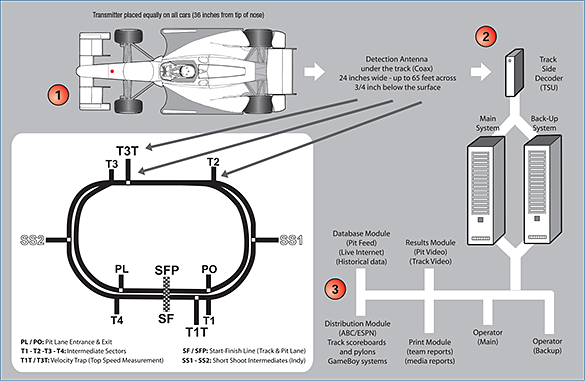Timing and Scoring

1. CAR A two-way radio transponder with a unique identification number is installed on the bottom of each car, 36 inches from the tip of the nose cone.
2. TRACK Multiple detection loop antennas buried in the track surface and strategically located around the track record the passing time and identification of the radio transponder attached to each car. The information is recorded and relayed to the timing and scoring booth via a trackside decoder that is connected to each antenna. The information from the trackside decoders is processed by primary and secondary scoring computers (servers) to determine the results of the session. Data that is recorded by the scoring servers includes the results of each session, all data from the transponders passing each loop antenna and all times of predetermined sections set up in the system. The system records all times to the ten-thousandths of a second.
3. BACK-UP SERVERS Several other systems are used to back up the main electronic scoring systems. A high-speed camera, which takes a picture every ten-thousandth of a second, records all start-finish line passings. Acquired in 2004 as a backup to the electronic system, the start-finish camera is used after every race to verify the finishing order of all cars. It also is used throughout the race to check close crossings. The camera played a vital role in determining the race winner at Chicagoland Speedway in 2008, when it showed Helio Castroneves edged Scott Dixon by 0.0033 of a second, even though the timing screen showed Dixon had won. In addition, two high-frame-rate cameras connected to a digital video system record video evidence of all start-finish line passings.
The scoring computers feed live timing data to each team's pit stand via the INDYCAR timing and scoring stand located in pit lane at the start/finish line. All data recorded at each race event is archived and made available to teams, manufacturers and race officials.
The system also features two-way communication availability through the car transponder. This allows INDYCAR timing and scoring the ability to send information to the car's on-board system as well as read information from it.